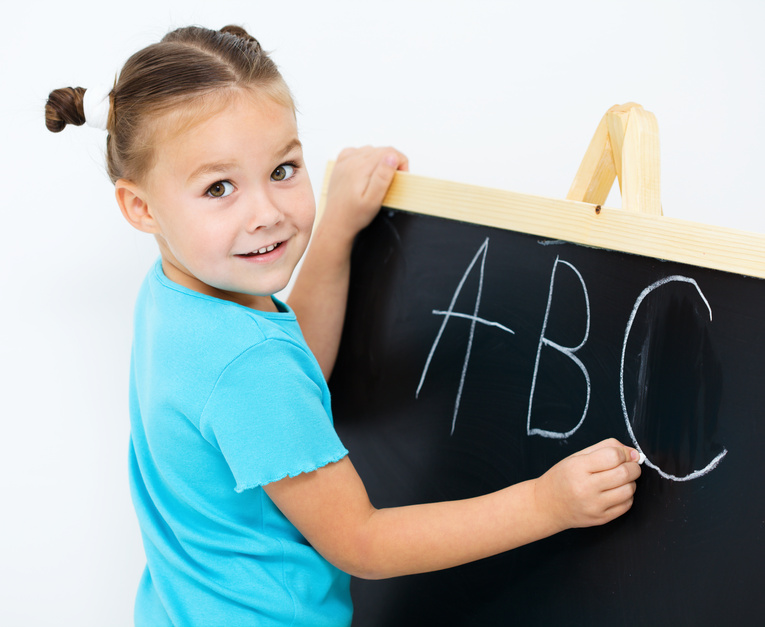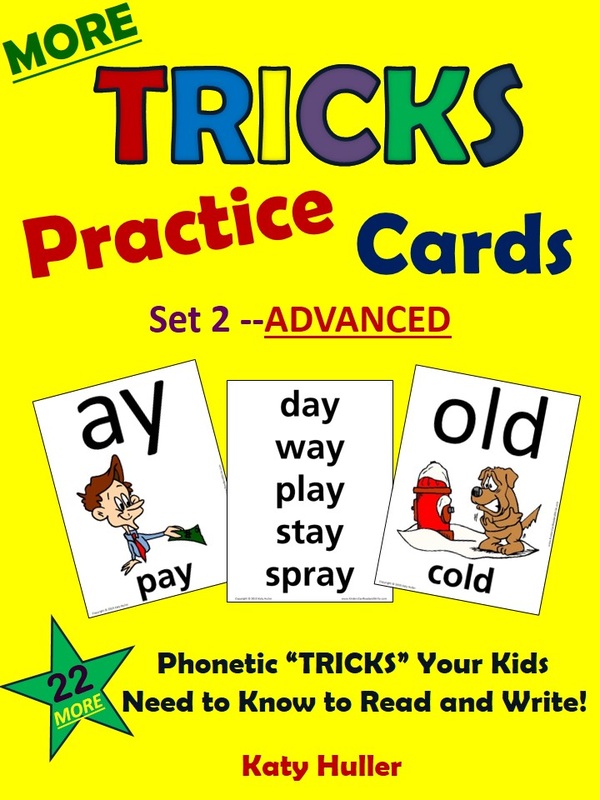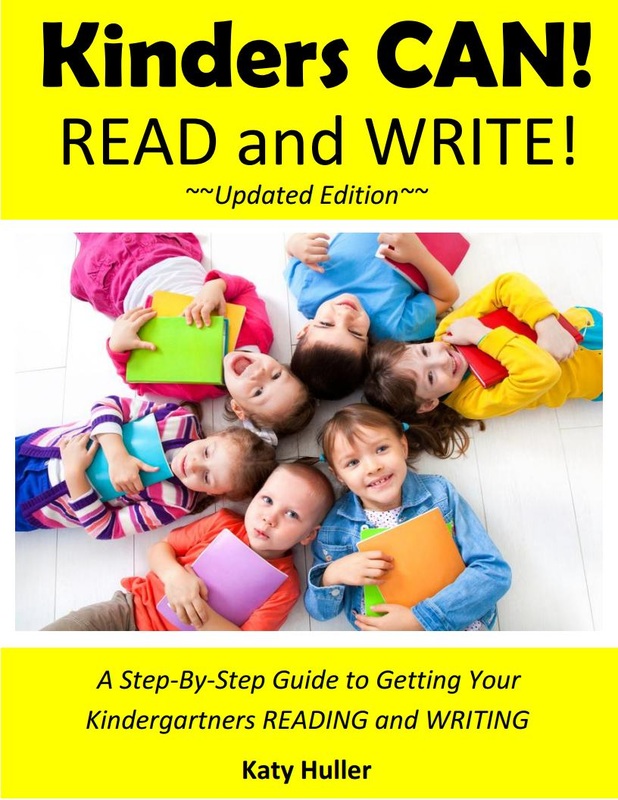Kindergarten has changed over the years! With more and more kids learning letters and sounds at home and/or in preschool settings, Kindergarten has become a time for kids to put their letter/sound knowledge to work! As a result, it's more important that ever that you make sure your child is ready to read and write by Kindergarten. By this time, your child should have a wide vocabulary and a broad understanding of the world around him or her. He or she should have been exposed to numerous books, movies, plays, experiences, and conversations. Ideally, he or she should know all the letters and sounds (out of order) and should have a growing understanding of how to blend letter sounds together to make words. He or she should also know how to write his or her first and last name. If you are behind in any of these areas, begin filling the gaps as soon as you can! Read the tips below to find out more!

- Continue to talk to and explain new things to your child. Your child's vocabulary and understanding of the world should really be exploding at this point. The more you talk about, the more your child will learn. Remember to read a variety of books to your child as well. Your child will take in just about anything you share with him or her.
- Continue to visit new places. Visiting new places is a great way to expand your child's world. If you live in the city, go visit the country. If you live in the country, go visit the city. The more places you expose your child to, the easier it will be for him or her to gain a better understanding of his or her part of the world.
- Make sure your child knows all of the letters and sounds. Knowing how to sing the alphabet song is not the same as knowing letters and sounds. Your child should be able to quickly identify any letter (capital or small) in isolation. He or she should also be able to instantly tell you the sound that letter usually makes. Because a few letters look different in print, make sure you expose your child to those variations as well.
- Make sure your child knows how to blend sounds together to make words. The whole point of teaching your child letters and sounds is to prepare him or her for blending those sounds together into words. As soon as your child can identify letters and sounds effectively, you need to show your child how to sound out words using these sounds. Stick with consonant-vowel-consonant words in the beginning. Help your child sound out words like pig, cat, dog, pen, has, bit, etc. Then have your child use the word in a sentence to make sure he or she understands what he or she is saying.
- Help your child read simple sentences. As your child learns how to read words, you'll want to get him or her reading sentences as well. This is an important step in the reading process. Steck Vaughn Phonics Readers are great for this. Look for titles such as Bob Has A Job or A Pet for Jen. My book, Kids Can! READ and WRITE! 2 and 3 Letter Words! has lots of sentences to practice reading as well. Whatever you read should be full of purely phonetic words, not "sight words." Your goal is to train your child to sound out words, not guess at them. To do so, the words must make sense to your child when he or she tries to sound them out. If you have to, make up your own sentences until your child knows enough "tricks" to read Dr. Seuss books.
- Begin introducing the "tricks" to your child. To read effectively, your kids need to know the "tricks" (letter combinations that make the letters say different things than they normally do on their own). Some examples of common tricks are: sh, ch, th, er, or, ou, y endings, ar, gh, ay, all, ew, and tion. "Sleepy e" and "2 vowels walking" words also fall under the "tricks" category. All of these are important for your child to know when beginning to read. Without this knowledge, reading will most likely be very difficult and challenging. My Free Word Card Program can help you teach them. So can my Tricks Practice Cards. Teach the "tricks" in the order they are listed on the Word Card page for best results, making sure your child can blend cvc words and blends first.
- Help your child make sense out of "sight words." If your child's teacher sends home "sight words" for your child to learn, make sure you practice them in a way that makes sense to your child. Instead of flashing cards in front of your child's face and asking him or her to simply tell you what it says, help him or her sound them out. Although not all "sight words" can be sounded out (through, because, though, eight, etc.), many can be when your child knows how to blend and is aware of the many "tricks" that commonly hide in words. It is much more effective to teach your child the "tricks" and help him or her sound out words than to force him or her to memorize every word in the English language! After your child sounds out the words enough times (its different for every child), the words will naturally become "sight words" (words kids know by sight). Another way to help them learn "sight words" (once they know how to blend and can easily spot and identify the many "tricks" hiding in words) is to help them read Dr. Seuss books. They are filled with the sight words your kids need to learn, but also have lots of words that can be figured out as well. When your child gets to words that can't be figured out, simply help him or her sound them out and adjust them into what they actually say. This is a very effective way to teach words that don't follow any of the normal rules or tricks. Start out with Green Eggs and Ham and The Cat in the Hat. Then move into books like Are You My Mother, Fred and Ted Go Camping, It's Not Easy Being a Bunny, I Wish That I Had Duck Feet, Flap Your Wings, and A Big Ball of String. All of these are good for beginning readers with knowledge of tricks.
- Read to your child ABOVE his or her reading level. Even though your child is learning to read on his or her own, it's important that you continue to read to your child as well. Choose books that are enjoyable for your child to listen to but beyond his or her personal reading level. This will help continue to develop your child's vocabulary and get him or her ready to read more advanced books on his or her own.
- Have your child read to you. Although you want to continue reading to your child, you also want your child to read to you. Choose phonetic books without too much print to begin with. As mentioned before, Dr. Seuss books are great for kids who are still sounding out words but who are aware of the many "tricks" lurking within them. When your child becomes fluent with those, move onto harder books. Just make sure the amount of print is not overwhelming to your child. Continue to advance your child into more difficult books as appropriate. Once they can read Dr. Seuss books fluently, they should be ready for any children's book within their interest level. Let your child pick out books he or she wants to read. Motivation is half the battle!
- Get your child writing! Writing is a lot like reading. It requires many of the same skills. To write effectively, your child will need to know letters, sounds, tricks, and some sight words. He or she will also need to have a very important skill called "segmenting." Segmenting is the opposite of blending. Instead of looking at letters and sounding them out, he or she will need to be able to hear a word and break it into sounds. "Cat" will become /c/ /a/ /t/. "Farm" will become /f/ /ar/ /m/. When your child knows letters, sounds, and tricks, and is able to segment words like this, writing words should come very easily. If it doesn't, your child is probably still lacking one of the skills mentioned, knowledge of "tricks" and/or segmenting usually being to blame. Make sure your child has the skills he or she needs and get him or her writing as soon as possible! You can call out words for your child to write in the beginning to help him or her get the hang out of how to do so. When you call them out, segment the word for your child and ask him or her what he or she hears. Have him or her write down the sounds in order. Then point to the letters he or she wrote, and show him or her how to sound the word out to check to see if he or she got it right or not. As soon as you can, move your child into writing stories, letters, emails, plays, etc. Help with spacing, punctuation, capitals, etc. as needed, explaining why they are needed and when they are used. With daily practice and one on one help, your child should be a pro in no time!
- Get help for any speech or language issues still remaining. If your child is still struggling with any speech or language issues, get help immediately. These can severely impact reading and writing skills. Make sure you are not reinforcing bad habits by repeating words incorrectly, no matter how "cute" it sounds. Instead, help your child hear how to say words correctly, and model how he or she should position his or her tongue to make the sounds required. Make sure you encourage good language skills as well, asking your child to speak in complete sentences and to use "big kid" words instead of "baby talk" or "whiny voices." If you can't understand what your child is saying, ask him or her to slow down and enunciate his or her words more carefully. Let him or her know that you are truly interested in whatever he or she has to say, and that you want to make sure you hear him or her correctly. Stress the importance of speaking thoughtfully at school as well.
- Continue feeding your child nutritious foods. Nutrition is important for a healthy body as well as a
healthy mind. Limit processed foods and sugar, and replace them with
healthier choices such as wild fish from nonpolluted waters, lean meats,
organic fruits and vegetables (whenever possible to avoid pesticides,
etc.), low-fat dairy products, water, and 100% fruit juice.
- Make sure you child is getting enough sleep! Your child still needs a lot of sleep at this age. Do what you can to make sure your child gets it.
Do Your Kids Already Know Their Letters and Sounds?
Show them how to blend letter sounds together and/or segment them apart so they can read and write their first words!
|
Having Trouble Teaching Your Kids Letters and Sounds? Worried Your Child Might Have a Learning Disability?
|
Kids who struggle to learn their letters and sounds may indeed have a learning disability. Or, they might just not be quite "ready" yet. It's also possible that they just haven't been taught in a way that works for them! Vary your approach. Your child might learn best by hearing, seeing, doing, or a combination of all of the above! Make your lessons fun and interactive. And as you do each one, make sure you are mentioning both the letter's name and sound as frequently as you can.
|
Teaching Letters and Sounds!
Whether your child has a learning disability or not, you still need to help him or her learn all 26 letters and sounds! Make sure you teach lowercase letters as well as the capital ones. Below are some tips:
1. Connect each letter with its sound. Always say both together at first, pulling the letter's name apart from its sound afterward. For instance, when doing a letter puzzle you might say, "I have b /b/, what do you have?" Then you might follow with, "Oh, I found where the b goes!" When reading a book, you might say, "Bb/b/ Bear! " Then you might ask, "What letter is this?...What sound does it make?...What's the picture of?" It's important that your child be able to quickly access the sound the letter makes when he or she sees the letter. By hooking this information together for your child, he or she is likely to be able to retrieve it much faster, even if he or she ends up being dyslexic and/or struggling with a learning disability of some sort. 2. Try to help your child see helpful reminders in the letters themselves. For instance, you might say, "This is a b! It has a baseball bat first, then a ball!)" Trace your fingers on the letter as you describe it. Review it until your child knows it. 3. Review OFTEN! Kids with memory issues learn and forget. The key is to talk so much about letters and sounds that they can't help but remember them! Don't get frustrated with your child if he or she can't remember what he or she "knew" a second ago; just reteach it. The more relaxed and happy your child is, the more receptive his or her brain should be. 4. Vary your approach. Read alphabet books, do alphabet puzzles, play with bathtub letters, etc. Make learning letters and sounds FUN! 5. Surround your kids with letters! Put magnetic letters on your refrigerator! Add bathtub tiles to your child's bath. Put a letter your child is struggling with on a favorite ball and throw it back and forth, naming the letter and its sound each time you catch it. Get letter/sound games and apps. Hang up an alphabet posters in your child's room and bathroom. Letters should be everywhere! 6. Teach your child how to sound out words! As soon as your child knows enough letters and sounds, start making words with them and practice helping your child sound them out. Often, having a reason to learn things makes learning easier! It will also give your child lots of practice using what he or she is learning which will help it stick better. |
Your kids need to know letters and sounds!
Make sure you teach LOWERCASE letters as well as capitals!
|
Ready to Get Your Kids READING and WRITING???
Utilize Our FREE Word Program!
Directions for utilizing Free Word Card Program:
|
Move Your Kids PAST Simple Words and Sentences -- Teach Them the TRICKS!
Your kids need to know the "tricks" in order to read more than simple consonant-vowel-consonant words and/or words with blends. As soon as your kids are blending and segmenting simple sounds with ease, begin teaching them the "tricks."
|











